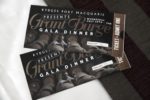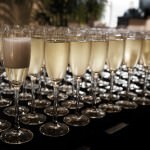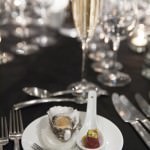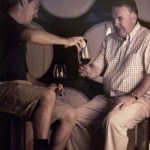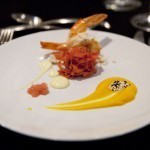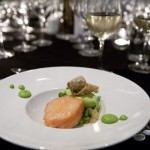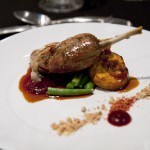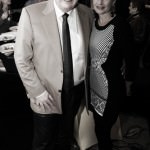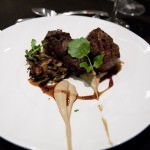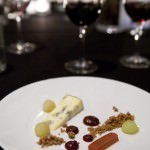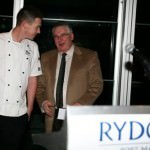An evening with Grant Burge, the man and the wine!
Mr GG and I have made the two hour drive to Port Macquarie to join wine maker Grant Burge in a six course degustation dinner featuring unique wines from his prestigious Barossa Valley vineyards. The evening was to be held at the Rydges Hotel with chef Adam Tate given the duty of designing a menu to showcase each of the wine varieties.

The evening began with a glass of NV Blanc de Noirs, a delicate and elegant wine, with fine bubbles and a creamy mouth feel. Grant explained the term Blanc de Noirs literally means white from black and describes the practise of using the red, pinot noir grape to make a white wine.
The wine making process and nuances of the NV Blanc de Noirs were further discussed by Grant as we feasted our eyes on the matched course. On the table were two delicate seafood dishes. The first was tuna mojama and pistachio, served with preserved lemon salsa and chorizo oil. The tuna was a perfectly sliced piece of fresh sashimi tuna and it melted in my mouth, the pistachio provided a crunchy contrast and had been roasted to give a crisp, smokey flavour.

The second dish on the plate was a fresh natural oyster served with champagne gel. Oh I do love a luscious fat oyster, and this one tasted of the sea and a fresh elegance that was the champagne gel.
We were off to a perfect start.
Grant chatted about the Burge family history in the Barossa Valley. He is the 5th generation of vigneron and winemaker, so it would be fair to say there is wine running through his blood. He spoke passionately about his selection of vineyards containing old vines, on original root stock. He believes strongly that these are the key to his success in producing premium quality wines. Some of the vines he holds dearest were planted in 1887!
Perhaps it is true in part, but perhaps also the man is too modest!

Our glasses are then filled with the 2012 Thorn Riesling. It is a lovely pale green with the aroma of apples and lime. The flavour is crisp, fresh and clean, with the citrus flavours shows through again. This wine was a pleasant surprise to me as I am not usually a Riesling drinker. The Thorn Riesling however is light and well balanced, and not overly sweet, all of which appealed to me.
The matching dish was seared prawn with an impossibly creamy, buttery, silken carrot puree and pickled vegetable salad. This dish was just bursting with flavour from the red finger lime to the creamy garlicky aioli. It was finish with a lovely sweet halva style crumble. Such a lush sensory dish, which was matched perfectly with the Riesling.

“Wine makers don’t make wine… they just muck up the grapes the least.” Grant Burge.
Another example of this man’s modesty!
Grant attributes great wines to great grapes. He is a champion of the Barossa Valley and notes that the growing conditions are similar to that of a Mediterranean climate.
It is time to move on to the 2012 Summers Chardonnay, which presents gorgeously gold in the glass. The grapes for this wine were taken from the highest Barossa Valley vineyards and Eden Valley in the Adelaide Hills. The blend of cool climate grapes has produced a wine with soft peach, nectarine flavours. The subtle use of French oak has added some depth and complexity and given the wine its delicious toasty almond characteristics. The flavours are creamy, mild, fine and delicate and Grant suggests this wine will further mature over the next 18 months to 6 years.

Presented with the 2012 Summers Chardonnay was our third course for the evening, a Sous Vide Salmon served with a melody of pea. The peas were served three ways, a pea puree adorned the plate, rich and creamy. The salmon was presented on a super light and airy pea mousse and finally a warm eschallot and confit lemon, salsa styled salad containing baby peas which were a sweet contrast to the lemon salad and popped deliciously in my mouth.
The salmon was amazing, it seemed to just melt in my mouth. Not having been ever touched by direct, drying heat, but cooked with all the moisture of the fish still in tact. It was a magically eating moment.
When a wine goes by the name of “The Holy Trinity” it’s making a huge statement.
This particular Holy trinity is the union of Grenache, Shiraz and Mouvedre grape, blended in the manner of wines from the Southern Rhone region of France. The grapes are all grown in the Barossa due to the suitability of the region for these varieties. The wine itself is deliciously fruit flavoured, with a rich cherry and plum base, followed by a deep earthy spiciness of pepper and aromatics. Nearly 40 % of the grapes for this wine came from vines which were planted in the 1890’s.

A wine steeped in history and tradition and produced using rare, old, low yielding vines. The vines were planted at a time when the Barossa Valley was a highly religious congregation, and church records were a more complete documentation of the happenings of the locality. It was Grants preacher who put forward the name for the wine as “The Holy Trinity” meaning the father, the son and the Holy Spirit blended as one wine.
Confit duck with beetroot relish, sweet potato and chilli cashew crumb was chosen to accompany the wine. The fruit and spice flavours of the wine complimented the moist gamey duck beautifully. The meat was literally falling of the bone and it was mouth-wateringly good. I loved the slightly salty, rich meaty flavour alongside the sweet, sticky, jammy beetroot relish. The piece de resistance for me was a finishing square of crispy fried duck skin.
Moving down the wine selection we arrive at the fifth wine for the evening, the 2006 Filsell Shiraz. This is the red of my dreams, luscious full berry flavours, and the deepest ruby red colour. The Shiraz was so tantalizing on the palate with hints of rich chocolate and cinnamon spice. It had a beautifully aged intensity that only a fine red will achieve.

As with all the Grant Burge wines there is a story behind the label. The grapes from the 2006 Filsell Shiraz heralded from one of the best vineyard in the Barossa Valley. Grant tells the story of acquiring these gnarly vines which were planted in the 1920’s. The family were selling due to the lack of an heir. Grant bought the vineyard and the season’s crop. He offered the highest price of any vineyard at the time, paying $10,000 per acre when vineyards at that time were worth just $2,000 per acre.

To match this complex wine, chef had prepared a beef fillet which was served perfectly rare and had a beguiling smoky flavour. Alongside the fillet was a braised beef cheek which was so moist and tender it fell apart at the mere touch of my fork. The beef was accompanied by a melody of earthy mushroom dishes and a “Pomme Anna.” The mushroom puree was so lusciously creamy it provided a rich sauce for the generously portioned beef. The sticky truffle Jus was the obvious highlight of the dish, but I really felt that I would have liked a little more shaved truffle in the jus. The taste of truffle was extremely subtle and in fact, it needed to be sampled on its own to distinguish the truffle flavour at all. All the same it was a very upmarket plate of meat and potatoes, and the perfect dish to enjoy with such a magnificent red.
With the meal drawing to a close I was looking forward sampling the Grant Burge 10 year old Muscat. It was poured and presented in all its burnt caramel glory! The aroma was of the most luscious plum pudding, the flavour of sweet raisins, ginger and sticky date pudding. It was such a warm full palate experience, perfectly balanced and velvety smooth with a clean fresh finish.

The accompanying dessert read;
Shadow of blue, quince paste, rye crumbs, apple and rhubarb.
Such an intriguing description, I was hoping for a styled apple & rhubarb crumble with blue and quince paste somehow woven into the mix. What was presented was a dish which was a cross between a fruit and cheese platter and a deconstructed apple & rhubarb crumble.
This was my least favourite dish of the evening. I didn’t feel the flavours or textures had any real relationship. The balls of apples were still quite firm and the blue cheese was much too salty for the other components. Texturally and taste wise the dish just didn’t excite me. As a standalone component the soft, sweet quince paste was music to my mouth, and possibly the best I‘ve had to date. The dessert was a disappointing finish to an otherwise exquisite meal.

It was time to thank the Chef Adam Tate for constructing such a complimentary menu. Grant said he found the food matches totally satisfying.
I learned so many interesting facts about the wine industry and the Barossa Valley during our meal. It surprised me to learn that in Australia we have almost 3000 wineries, but only 25% are privately owned. Grant Burge Wine is a privately owned family business. Grant spoke about the importance of ongoing consumer support, stating that he is “a very smaller player in a large industry”.
Grant Burge the man is full of stories, history and good old fashion Barossa Valley roots, old vine roots to be precise, quality.
Whether it’s vine selection, the Barossa mediterranean climate, 5 generation of knowledge and skill as winemakers, or the overwhelming passion of a man, one thing is certain, Grant Burge makes premium quality wine.
So readers, have you tried any of the Grant Burge wines? What is your favourite wine at the moment?
